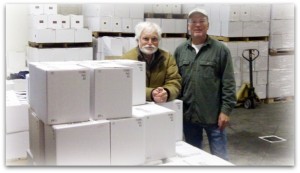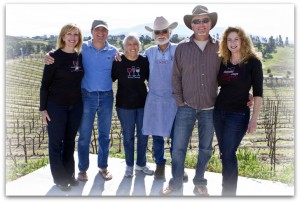 When Joe Hart planted his first acre of grapes, there were no stop signs in Temecula. For that matter there wasn’t a supermarket, either. Hart and Filsinger Wineries joined Callaway, Mt. Palomar and Cilurzo in 1980, becoming the 4th and 5th Temecula Wineries. Today nearly 40 wineries dot Temecula Valley Wine Country. I sat down with Joe recently to learn from him what changes he has seen over the years.
When Joe Hart planted his first acre of grapes, there were no stop signs in Temecula. For that matter there wasn’t a supermarket, either. Hart and Filsinger Wineries joined Callaway, Mt. Palomar and Cilurzo in 1980, becoming the 4th and 5th Temecula Wineries. Today nearly 40 wineries dot Temecula Valley Wine Country. I sat down with Joe recently to learn from him what changes he has seen over the years.
I knew this was going to be an interesting visit when Joe told me he grew up in a non drinking family. His first taste of wine was at a country inn on the Swiss border while he was stationed in Europe in the mid ’50s. “They had wine on the table so I said ‘what the heck, I’ll try it’.” He remembers it was a local white wine and it paired beautifully with the food he ate. Later in Venice, there was a carafe of local red wine on the table. Dining canal-side, he was intrigued and found he enjoyed it, too and it also paired well with his meal. Thus Joe’s passion for wine was born.
Joe started studying about wine, attended some classes at UC Davis and decided this was something he had to do. Living in Carlsbad and teaching science and social studies to Jr. High students, his passion for wine was growing. He had been taking a look at Temecula and felt it had promise, so he purchased some land in 1974 and planted his first acre of grapes. The next year he planted four acres. At the end of three years, he had planted seven acres and was producing a lot of fruit. In 1979 he decided to take a year’s leave from teaching and try his hand at making wine. He had already made what he describes as some “pretty mediocre” wines at home, but with some studies under his belt he produced 300 cases of wine and opened Hart Winery in 1980.
At the time, there was virtually no traffic on Rancho California Road. The winery was open on Saturdays only, and they tasted off the end of a turned wine barrel. They had about 10 glasses, but that was plenty. Joe says they had lots of time to read. In the early ’80s, Sunset magazine did a feature on Temecula’s wine country and traffic began to increase. He also gives Eli Callaway a lot of credit for puting Temecula on the map, calling him a master salesman. A campaign Callaway launched ruffled some feathers, however: “White Wine Is All We Make”. Joe says the German winemaker Callaway had at the time was trained in whites, primarily Riesling and the reds he produced weren’t so good. The inside joke at the time was “white wine is all they know how to make.”
He continues his wine education to this day, taking extension classes at Davis in white wines, red wines, filtration, finance and marketing. Technology and equipment has evolved tremendously since he became involved with wine. The tools are far more sophisticated and gentler on the fruit. He’s constantly upgrading the winery’s equipment and replacing barrels with higher end products. Joe has always felt wine is meant to be enjoyed with food and he applies that philosophy to his wine making. Joe notes that Robert Parker had a tremendous impact on the wine industry and believes Parker is responsible for the shift to more extracted, higher alcohol wines. Hart has seen a trend back to more elegant wines with alcohol levels at 14% or less.
We spoke about Temecula’s identity as a wine region, or rather lack thereof. Joe believes several elements factor into it. The Temecula Valley is primarily a direct sales region and wineries feel they need to offer their customers a wide array of choices. Paso Robles was just beginning to gain a reputation when the first grapes were being planted in Temecula. He feels Paso Robles has done a far better job of carving out an identity. It’s been difficult, he says, to get agreement on what Temecula’s identity ought to be.
There is a slow transition taking place at Hart Winery as Joe allows himself to spend more time away from day to day operations. Son Jim is following in his dad’s footsteps, having left his profession as a teacher to go into the wine business. Joe is extremely proud of Jim, not only in how well he learned his craft at Hart, but also in the job he is doing in Ramona as winemaker at Milagro Farm. Jim, he says, has an intuitive feel, is a good listener and solid academically. It makes sense to me. Jim learned from one of the best.


